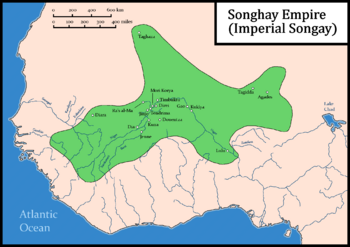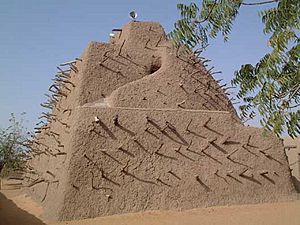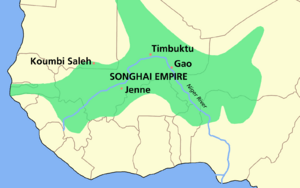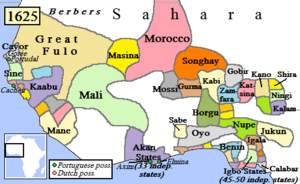Songhai Empire facts for kids
Quick facts for kids
Zaghai (Songhai) Empire
|
|||||||||||||||
|---|---|---|---|---|---|---|---|---|---|---|---|---|---|---|---|
| c. 1430s–1591 | |||||||||||||||

Territory of the Songhai Empire
|
|||||||||||||||
| Capital | Gao | ||||||||||||||
| Common languages | |||||||||||||||
| Religion | |||||||||||||||
| Emperor | |||||||||||||||
|
• 1464–1492
|
Sunni Ali | ||||||||||||||
|
• 1492–1493
|
Sonni Bāru | ||||||||||||||
|
• 1493–1528
|
Askia the Great | ||||||||||||||
| Historical era | Early Modern Era | ||||||||||||||
|
• Songhai state emerges at Gao
|
c. 7th century | ||||||||||||||
|
• Independence from Mali Empire
|
c. 1430s | ||||||||||||||
|
• Sonni dynasty begins
|
1468 | ||||||||||||||
|
• Askiya dynasty begins
|
1493 | ||||||||||||||
|
• Saadian invasion of the Songhai Empire
|
1591 | ||||||||||||||
|
• The Nobles moved south to present-day Niger and formed various smaller kingdoms
|
1591 | ||||||||||||||
|
• French depose last Askia of the Dendi
|
1901 | ||||||||||||||
| Area | |||||||||||||||
| 1550 | 800,000 km2 (310,000 sq mi) | ||||||||||||||
| Currency |
|
||||||||||||||
|
|||||||||||||||
The Songhai Empire was a powerful state in West Africa. It existed during the 15th and 16th centuries. At its strongest, it was one of the largest empires in African history. The empire is named after the Songhai people, who were its main ethnic group and ruling family.
Sonni Ali made Gao the capital city. However, a Songhai state had been around Gao since the 11th century. Other important cities were Timbuktu and Djenné. These cities were centers for trade. They were taken over in 1468 and 1475. The Songhai Empire was first ruled by the Sonni dynasty (around 1464–1493). Later, the Askia dynasty (1493–1591) took over.
In the late 1200s, Gao became a major trading hub. This caught the attention of the growing Mali Empire. Mali conquered Gao around the end of the 13th century. Gao stayed under Mali's control until the late 1300s. As the Mali Empire grew weaker, the Songhai people took back control of Gao. Songhai rulers then used Mali's weakness to expand their own empire.
Under Sonni Ali, the Songhai Empire grew larger, richer, and more powerful than Mali. It took over huge parts of the Mali Empire. His son, Sonni Bāru, was overthrown by Muhammad Ture. Muhammad Ture was one of Sonni Ali's generals. He is better known as Askia the Great. Askia the Great made many changes to the empire's government and economy.
After Askia the Great, there were many power struggles and civil wars. These events caused the empire to become weaker and unstable. Askia's family tried to rule, but the political chaos continued. The empire kept declining, especially during the rule of Askia Ishaq I. However, the empire had a period of peace and military success under Askia Daoud.
Askia Ishaq II was the last ruler of the Songhai Empire. He came to power after a long fight for the throne when Daoud died. In 1590, Al-Mansur of Morocco saw the empire's internal problems. He sent an army led by Judar Pasha to conquer the Songhai. Morocco wanted to control the important trans-Saharan trade routes. The Songhai Empire fell after losing the Battle of Tondibi in 1591.
Contents
History of the Songhai Empire
Early People of Songhai
The Songhai identity formed over time from different groups of people. This happened between the 9th and 3rd centuries BCE. The area around ancient Kukiya was a key center.
The Sorko people were among the first to settle near Gao. They built small villages along the Niger River. The Sorko were skilled at making boats from trees. They fished, hunted, and transported goods and people by water.
Another group, the Gao people, also lived off the Niger River. They were hunters, especially good at hunting river animals like crocodiles and hippos. The Do people were farmers. They grew crops in the rich lands along the river.
Before the 10th century, stronger, horse-riding Songhai speakers took control. They ruled over these early settlers. Slowly, all these groups began to speak the same language. They and their land became known as the Songhai.
Gao and the Mali Empire
The first kings of Songhai are not well known. Most information comes from an old cemetery near Saney. Tombstones there show that early kings ruled in the late 11th and early 12th centuries. They were called Malik (Arabic for "King").
The Sanhaja tribes were early people in the Niger Bend area. They came from the Sahara Desert. They set up trading posts near the Niger River. Later, traders from North Africa joined them. Both groups traded with people living near the river.
As trade grew, Songhai chiefs took control of the profitable trade around Gao. They traded gold, salt, slaves, and other goods. By the 10th century, Gao was a small kingdom. Around 1300, Gao became rich enough to attract the Mali Empire. Mali conquered Gao and collected taxes from its kings.
Mali controlled Gao until the 1430s. Then, problems in Mali made it hard for them to keep control. In the 1430s, Songhai became independent under the Sonni dynasty. About 30 years later, Sonni Sulayman Dama attacked a Mali province.
A traveler named Ibn Battuta visited Gao in 1353. It was still part of the Mali Empire then. He wrote that Gao was a "great town on the Nīl [Niger]". He called it "one of the finest, biggest, and most fertile cities of the Sūdān."
Sonni Ali's Rule
Sonni Ali ruled from 1464 to 1492. He was different from earlier Songhai kings. He respected the traditional religion of his people. This made some Islamic scholars see him as a harsh ruler.
In the late 1460s, he conquered many nearby states. This included what was left of the Mali Empire. Sonni Ali expanded his empire greatly. He fought off attacks from the Mossi people in the south. He also conquered the Dogon people in the north.
He took over Timbuktu in 1468. The city leaders had asked him to help remove the Tuaregs. The Tuaregs had taken Timbuktu after Mali became weak. Sonni Ali then tried to conquer the trading town of Djenné. The people of Djenné fought back. After a seven-year siege, he starved them into surrendering. He added Djenné to his empire in 1473.
Sonni Ali's actions affected Timbuktu. Many Muslim writers described him as a tyrant. He had a strict policy against scholars in Timbuktu. Especially those linked to the Tuareg. By controlling key trade routes and cities like Timbuktu, Sonni Ali made the Songhai Empire very rich. At its peak, it was wealthier than Mali.
Askia the Great's Reign

After Sonni Ali, Askia the Great became ruler. He organized the lands his predecessor had conquered. He also expanded the empire to the south and east. Under his rule, the Songhai army had full-time soldiers. Askia believed that kingdoms without professional armies were weak.
Askia opened religious schools and built mosques. He welcomed scholars and poets from across the Muslim world. His children went to Islamic schools. He encouraged Islamic practices but did not force people to convert. Askia completed one of the Five Pillars of Islam. He went on a hajj (pilgrimage) to Mecca. He brought a lot of gold with him. He gave some to charity and used the rest for gifts. This showed how rich his empire was.
Islam was very important to Askia. When he returned, he set up more learning centers. He hired Muslim scholars from Egypt and Morocco. They taught at the Sankore Mosque in Timbuktu. He was also interested in astronomy. This led to more astronomers and observatories in the capital.
Askia led many military campaigns. He declared Jihad against the nearby Mossi people. But he did not force them to become Muslim after defeating them. His army had war canoes, cavalry, and iron weapons. It was a well-organized fighting force.
He made the empire's government more centralized. He created a system to collect taxes and administer justice. He ordered canals to be built to improve farming. This helped increase trade. He also introduced a system of weights and measures. He appointed inspectors for major trading centers.
During Askia's rule, Islam became stronger. Trans-Saharan trade grew. The important salt mines of Taghaza became part of the empire.
Decline and Moroccan Invasion
In 1528, Askia's children rebelled against him. They made his son Askia Musa king. After Musa was overthrown in 1531, the Songhai Empire began to decline. When Emperor Askia Daoud died in 1583, a fight for the throne weakened the empire even more. It split into two fighting groups.
During this time, Morocco's army defeated a Portuguese invasion. But Morocco was left very poor. To get money, Sultan Ahmad I al-Mansur of the Saadi dynasty sent an army south in 1591. This army was led by Judar Pasha. Morocco wanted to take control of the trans-Saharan trade in salt, gold, and slaves.
Askia the Great had a strong army, but it was not modern. The Moroccan army, however, had thousands of soldiers with arquebuses (early guns). They also had eight English cannons. Judar Pasha was born in Spain but grew up in Morocco. His forces marched across the Sahara Desert. They captured and destroyed the salt mines at Taghaza. Then they moved towards Gao.
Emperor Askia Ishaq II (ruled 1588–1591) met Judar at the 1591 Battle of Tondibi. The Songhai army had many more soldiers. But they were defeated by a cattle stampede caused by the Moroccan guns. Judar then looted Gao, Timbuktu, and Djenné. This destroyed the Songhai Empire as a major power.
Ruling such a large empire was too hard for the Saadi dynasty. They soon gave up control of the region. It then broke into many smaller kingdoms.
After the empire's defeat, the nobles moved south. They went to an area in modern-day Niger. The Sonni dynasty had already settled there. They formed smaller kingdoms like Dendi. The Dendi Kingdom became important soon after.
How the Empire Was Organized
The original Songhai Empire was only the area from Timbuktu to the east of Gao. After military growth under Sonni Ali and Askia, the empire was divided. It had three main military zones:
- The kurma zone: This was in the west. The Balama, who was the defense minister and army general, was based here. He watched over the western provinces, including Mali. Garrisons (military posts) were here. The Balama also had part of the navy fleet at the port of Kabara. The Kurma Fari was another important person. He was the governor and lived in Timbuktu.
- The capital city of Gao: The emperor lived here with the main army. Part of the fleet was here too. It was led by the Hikoy, the empire's admiral. He had over a thousand ships at Gao's port. Most large military campaigns started from Gao. The emperor was helped by the Tondi farma in the south. He was the governor of Hombori. In the north, the Surgukoy was in charge. He was the chief of the Berbers and oversaw the desert provinces. He had an army of Camel cavalry.
- The Dendifari led the eastern province of Dendi. This governor had an army watching over the eastern provinces, including the Hausa kingdoms. The fleet was at the port of Ayorou.
At its largest, the Songhai Empire covered parts of modern-day Mali, Niger, Nigeria, Mauritania, and Senegal. It also included parts of other West African countries and Algeria. Its influence reached as far as Cameroon. It was a huge area with many different groups of people. These included Mandé peoples, Gur, Dogon, Berbers, Arabs, Fula, Wolof, Hausa, and others.
The empire was led by an elite group of Songhai horsemen. These riders came from East Africa long ago. They mixed with the Sorko fishing people and local farmers of the Niger River.
Songhai Culture and Economy
Economy and Trade
Trade on land in the Sahel and river trade along the Niger were the main ways Songhai became rich. Trade along the West African coast only became possible in the late 1400s. Several dikes were built during Sonni Ali's rule. These helped with irrigation and made farming better.
Land trade depended on four things: camels, Berber tribes, Islam, and the empire's structure. Gold was easy to find in West Africa, but salt was not. So, the gold-salt trade was very important. Gold, ostrich feathers, and slaves were sent north. In return, the Songhai received salt, horses, camels, and cloth. The Songhai often used the trade route through Fezzan via Bilma, Agades, and Gao.
The Niger River was also vital for trade. Goods were moved from camels to donkeys or boats at Timbuktu. From there, they traveled along the river. They went 500 miles upstream to Djenné or downstream to Gao.
Merchants, called Julla, formed partnerships. The government protected them and the port cities along the Niger. Askia Muhammad I created a standard system of weights and measures. He also appointed inspectors for major trading centers.
The Songhai economy was based on a clan system. A person's clan usually decided their job. Common jobs included metalworkers, fishermen, and carpenters. Lower social groups often included immigrants. Sometimes, these immigrants had special rights and important positions. At the top were nobles and descendants of the original Songhai people. Below them were free people and traders. At the bottom were prisoners of war and enslaved people. They mostly worked in farming. The Songhai used enslaved people more than earlier empires like Ghana and Mali.
Government and Religion
The upper classes in Songhai society became Muslim. But the lower classes often kept their traditional religions. Religious speeches taught people to obey the king. Timbuktu was a center for learning.
Sonni Ali set up a government system under the royal court. Askia Muhammad later expanded this. Governors and mayors were appointed to rule local areas around the Niger Valley. These local leaders could still manage their areas. They just could not go against Songhai rules.
The central government had different departments. The hi koy was like a minister of home affairs. The Fari Mondzo was the minister of agriculture. He managed the state's farms. The Kalisa farm was like the finance minister. He oversaw the empire's money. The Korey Farma was the "minister in charge of White foreigners."
Taxes were collected from smaller chiefdoms and provinces. This showed Songhai's power. In return, these areas had a lot of freedom. Songhai rulers only stepped in if there was a serious problem. Each town had government officials. They had jobs and duties similar to today's government workers.
Under Askia Muhammad, the empire became more centralized. He encouraged learning in Timbuktu. He gave professors more money to teach there. He also set up rules for how people should act in court. He was known for being generous to the poor. Askia's policies brought much stability to Songhai. Writers from North Africa, like Leo Africanus, wrote about how well-organized the empire was.
The Sonni dynasty practiced Islam but also kept many Songhai traditions. The Askiya dynasty was different. Askia Mohammed I led a full Islamic revival. He also made a pilgrimage to Mecca.
Songhai Military
The Songhai army was strong and well-organized. It included a navy led by a hikoy (admiral). There was also a cavalry of mounted archers, foot soldiers (infantry), and a camel cavalry. They even trained large bulls to charge at the enemy in battle. Vultures were used to bother enemy camps.
The emperor was the main leader and commander of the army. The balama was the minister of defense and a general. The janky was a general for army groups. The wonky were lieutenants in charge of military posts. The leader of the mounted archers was called the tongue farma.
The hike was second in command of the empire. He acted like an interior minister. He had two vice-admirals at the ports of Kabara and Ayourou. He commanded over a thousand captains. This helped troops move quickly along the Niger River.
The infantry was led by a general called the nyay hurry (war elephant). The camel cavalry, called gu, was led by the guy, or cavalry chief. The cavalry was mostly made up of Berbers from the northern areas.
The Songhai had three military provinces. An army was stationed in each. The kurmina province's army was led by the balama. The emperor led the central province's army. The dendi province's army was led by the dendi fari. The army of the closest province would join the emperor's army for major wars. Other soldiers stayed behind to keep order. The emperor had to lead his army in person during a war of conquest.
The Songhai army had heavy cavalry with "mounted knights wearing chain mail and helmets." This was similar to medieval European armies. The foot soldiers included free people and captives. They used swords, arrows, and shields made of copper or leather. At the Battle of Tondibi, the Songhai army had 30,000 foot soldiers and 10,000 cavalry.
Important Rulers of Songhai
Here are some of the important rulers of the Songhai Empire:
Songhai Dias (Kings)
| Name | Reign Start | Reign End |
|---|---|---|
| Alayaman | c. 837 | c. 849 |
| Za Koi | c. 849 | 861 |
| Takoi | 861 | 873 |
| Akoi | 873 | 885 |
| Ku | 885 | 897 |
| Ali Fai | 897 | 909 |
| Biyai Komai | 909 | 921 |
| Biyai Bei | 921 | 933 |
| Karai | 933 | 945 |
| Yama Karaonia | 945 | 957 |
| Yama Dombo | 957 | 969 |
| Yama Danka Kibao | 969 | 981 |
| Kukorai | 981 | 993 |
| Kenken | 993 | 1005 |
| Za Kosoi | 1005 | 1025 |
| Kosai Dariya | 1025 | 1044 |
| Hen Kon Wanko Dam | 1044 | 1063 |
| Biyai Koi Kimi | 1063 | 1082 |
| Nintasani | 1082 | 1101 |
| Biyai Kaina Kimba | 1101 | 1120 |
| Kaina Shinyunbo | 1120 | 1139 |
| Tib | 1139 | 1158 |
| Yama Dao | 1158 | 1177 |
| Fadazu | 1177 | 1196 |
| Ali Koro | 1196 | 1215 |
| Bir Foloko | 1215 | 1235 |
| Yosiboi | 1235 | 1255 |
| Duro | 1255 | 1275 |
| Zenko Baro | 1275 | 1295 |
| Bisi Baro | 1295 | 1325 |
| Bada | 1325 | 1332 |
Songhai Sunnis (Sheikhs)
| Name | Reign Start | Reign End |
|---|---|---|
| Ali Konon | 1332 | 1340 |
| Salman Nari | 1340 | 1347 |
| Ibrahim Kabay | 1347 | 1354 |
| Uthman Kanafa | 1354 | 1362 |
| Bar Kaina Ankabi | 1362 | 1370 |
| Musa | 1370 | 1378 |
| Bukar Zonko | 1378 | 1386 |
| Bukar Dalla Boyonbo | 1386 | 1394 |
| Mar Kirai | 1394 | 1402 |
| Muhammad Dao | 1402 | 1410 |
| Muhammad Konkiya | 1410 | 1418 |
| Muhammad Fari | 1418 | 1426 |
| Karbifo | 1426 | 1434 |
| Mar Fai Kolli-Djimbo | 1434 | 1442 |
| Mar Arkena | 1442 | 1449 |
| Mar Arandan | 1449 | 1456 |
| Suleiman Daman | 1456 | 1464 |
Songhai Emperors
| Name | Reign Start | Reign End |
|---|---|---|
| Sonni Ali | 1464 | 6 November 1492 |
| Sonni Baru | 6 November 1492 | 1493 |
| Askia Muhammad I (First Reign) | 3 March 1493 | 26 August 1528 |
| Askia Musa | 26 August 1528 | 12 April 1531 |
| Askia Mohammad Benkan | 12 April 1531 | 22 April 1537 |
| Askia Ismail | 22 April 1537 | 2 March 1539 |
| Askia Ishaq I | 1539 | 25 March 1549 |
| Askia Daoud | 25 March 1549 | August 1582 |
| Askia Muhammad II (al-Hajj) | August 1582 | 15 December 1586 |
| Muhammad Bani | 15 December 1586 | 9 April 1588 |
| Askia Ishaq II | 9 April 1588 | 14 April 1591 |
Songhai Emperors (ruled in exile from Dendi)
| Name | Reign Start | Reign End |
|---|---|---|
| Muhammad Gao | 14 April 1591 | 1591 |
| Nuh | 1591 | 1599 |
| Harun | 1599 | 1612 |
| Al-Amin | 1612 | 1618 |
| Dawud II | 1618 | 1635 |
| Ismail | 1635 | 1640 |
| Samsou-Béri | 1761 | 1779 |
| Hargani | 1779 | 1793 |
| Samsou Keïna | 1793 | 1798 |
| Fodi Maÿroumfa | 1798 | 1805 |
| Tomo | 1805 | 1823 |
| Bassarou Missi Izé | 1823 | 1842 |
| Boumi (Askia Kodama Komi) | 1842 | 1845 |
See also
 In Spanish: Imperio songhai para niños
In Spanish: Imperio songhai para niños
- Za dynasty
- Sonni dynasty
- Askiya dynasty
- Saadi dynasty
- Mali Empire
- Dendi Kingdom
- Songhai languages
- Songhai country
- Songhaiborai




